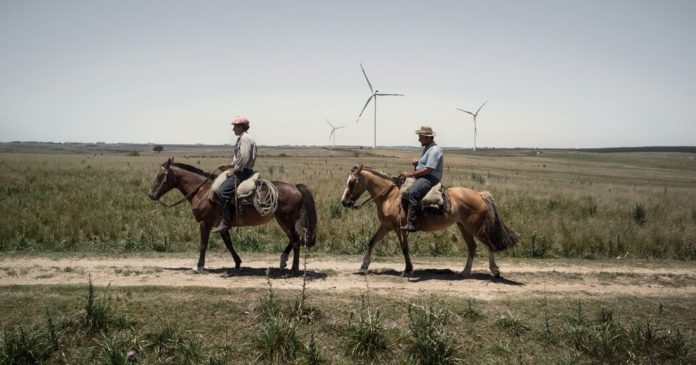Something of Uruguay’s character can be read as you descend toward it. One of the smallest and least densely populated countries on Earth, it is composed almost entirely of a single sweep of grasslands, which unfolds gently and is practically uninterrupted by cities or landmarks. Its highest point, Cerro Catedral, reaches 1,685 feet. Its ratio of cattle to people: 4 to 1. Even its official name, República Oriental del Uruguay, or Republic East of the River Uruguay, seems a modest commentary on its relationship to Argentina, whose capital, Buenos Aires, lies just across the water from Montevideo, like a fun-house reflection of a busier metropolis. Flat, quiet and often overlooked, the country has been called “the paradise of fat cows.”
The sky was full of low scudding clouds when I landed in early December. In Montevideo, an ocean breeze ran down the boulevards, which were lined with eucalyptus trees and worn Art Deco apartment buildings. After a year of restrictions, the cafes stood open and busy, and the rich were already leaving for their summer homes in Punte del Este. Along the Río de la Plata, which becomes the Atlantic Ocean east of the city, people walked what they call La Rambla, separated from the beach by a crumbling brick sea wall.
In the Cerro neighborhood, west of downtown, I sat beneath a painting of a jaguar in the living room of María Esther Francia. Francia was thin and 71 and wore a matching set of patterned pants and blouse, her dark hair held back loosely from oversize glasses. A former activist and health care worker, she had been an intimate observer of Uruguay’s past, and I was curious to hear what she made of its future. Her paintings — mostly landscapes and animals — hung everywhere in her small apartment. They suggested undercurrents. An emerald prairie extended across a brilliant horizon, while spectral figures toiled beneath in mudlike caves. Francia told me that she did not know what future Uruguay was headed toward, only that they were building upon the remains of its history.
Francia grew up in Salto, on the Argentine border, before moving to Montevideo in the 1960s. At the time, Uruguay was prosperous but embattled, the fledgling social democracy growing so unequal that a Marxist-Leninist group called the Tupamaros had begun robbing banks to distribute money to the poor. “What I earned working was not enough to eat,” Francia said. “And there were many people in much worse condition.” Uruguay’s relatively small size and concentration (about half of its 3.5 million people live in Montevideo) had long provided the country a collective sense of purpose — literacy was close to 95 percent and health care coverage was a universal right — but also brought its inequalities to a rapid boil. One of the Tupamaros’ more famous slogans read: “Everybody dances or nobody dances.”
In 1969, just three months after Francia was married, her husband, Alfredo Cultelli, was killed in the so-called Taking of Pando, when he and other Tupamaros seized the commercial hub. Four years later, while serving a prison sentence, Francia learned that the military had dissolved Parliament. Suspending the right to vote, the ruling junta adopted a neoliberal economic agenda inspired by the Chicago school and began conducting a widespread terror campaign. The twin policies all but broke the tiny country. Industrial productivity initially shot up, as the military cut tariffs and social entitlements. But all this growth came at a price. As the writer Eduardo Galeano once put it: “In Uruguay, people were in prison so that prices could be free.” By 1980, somewhere between 300,000 and 400,000 had been exiled and an estimated one in 500 was imprisoned — the highest percentage of political incarceration in the world — many of them subjected to torture, including Francia.
Then in 1982, the bottom fell out of the economy — the peso crumbled and the economy shrank by 16 percent in two years. When Francia returned from political asylum in Sweden in 1985, she found her once-prosperous country unrecognizable: The streets were so empty that residents joked that the “last person in the country had turned off the lights.” For much of the next couple of decades, unemployment and poverty fluctuated wildly, as the country struggled to free itself from collapsing economies in Brazil and Argentina and the weight of its own past.
In 2009, Uruguay elected an unlikely leader — José Mujica. A former baker’s assistant and flower merchant, Mujica had become notorious as one of the guerrilla leaders of the Tupamaros, with whom he staged at least one bank robbery, before being shot and arrested in 1970. He spent 13 years in prison, escaping at least twice, suffering torture and long stretches in solitary confinement at the bottom of a well. After his election, Mujica’s image as a populist folk hero was only further burnished by his deep commitment to social welfare and simplicity. Forgoing the presidential palace, which he opened to the homeless, he chose to continue living on his chrysanthemum farm, donating 90 percent of his salary to charity and driving his 1987 Volkswagen Beetle to Parliament. Today he’s considered by many in Uruguay and throughout the world as the archetypal Uruguayan.
Source : Nytimes












